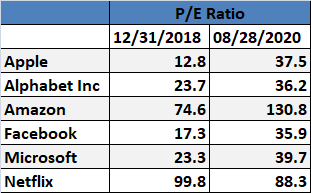“The definition of insanity is doing the same thing over and over again and expecting different results.” – Albert Einstein
It is well known that investors buy at market tops, when sentiment is unanimously optimistic and valuations severely stretched. We saw this in the late 1999’s during the dotcom bubble, with widespread euphoria around internet-related companies and record inflows into mutual funds. This was followed by a savage bear market in which the Nasdaq index fell more than 75% from its peak in March 2000. Fund outflows then reached a record high at the market bottom in late 2002, which of course was precisely the time an investor should have been buying.
The mistake of ‘buying high and selling low’ happens time and time again, to minimize the odds of this happening, it is worth adhering to a universal rule of investing which I observed some time ago. That there is a negative correlation between sentiment and future returns. An investment in which the public are the most bullish and expect outsized returns go on to generate subpar returns. Conversely an asset which has delivered miserable returns and is considered toxic, lays the foundation for future outperformance. Below are three examples of this and why I believe this rule now applies to the technology sector.
Gold bugs
A 2011 Gallup poll (conducted between Aug 11 -14) asked Americans what they think is the best long-term investment.
The results:
34% said Gold
19% said Real Estate
17% said Stocks
14% said Savings Accounts
And 10% said Bonds
Gold prices spiked in late 2011 following the sovereign debt crisis and inflation fears post the great financial crisis. This triggered record interest in the shiny metal, inflows into gold backed ETF’s (Exchange traded funds) peaked in 2011 and 2012, but as history has shown, by the time the masses show interest it is often too late. Following this poll gold declined precipitously and remained below its height for nearly 10 years until the recent pandemic induced rally. The sharp decline in gold prices triggered large outflows in 2013, 2014 and 2015 (according to market data company Markit). Individuals bought and sold at precisely the wrong times – a classic case of ‘buy high and sell low’.

Business Week Magazine
Another example is from the Business Week magazine, which penned a cover story titled “The Death of Equities” in 1979, what followed was a multiple decade bull market.

$1 invested at the beginning of 1979 (when equities were deeply unpopular) would be worth $29 at the end of 1999. The public exited equities at the worst possible moment, most people are not built for market timing.
Biotech optimism
Finally, I remember when the biotech sector was in vogue after a tremendous run (five-fold return) from the market bottom in March 2009. Once again investors piled in at the wrong time, biotech funds featured frequently amongst the most popular funds in the months running up to July 2015, when the Nasdaq biotechnology index peaked. It spent the next five years underwater until hitting new highs in the second half of this year.

In the UK where I’m based, Morningstar reports that the most popular funds in 2015 were Axa Framlington Biotech and Franklin Biotechnology discovery fund. And according to Hargreaves Lansdown, the largest investment broker in the UK, Axa Framlington Biotech was also their most popular fund in 2015. Chasing past performance, fuelled in part by herd mentality, recency bias and a fear of missing out (FOMO) is a recipe for destroying wealth, yet it happens time and time again.
Technological euphoria
Today crowds are pouring into technology stocks at a time when valuations have become highly stretched. One of the largest technology funds within the UK, Polar Capital Global Technology has soft closed after its assets ballooned to £4.5bn in the three months to the end of June. Technology funds are now the most popular funds across all major investment platforms within the UK, the key problem is that peak inflows tend to correlate with market tops. A quick look at the P/E ratios of the major technology firms shows that in most cases valuations have more than doubled in less than two years. The public’s sudden enthusiasm for this sector coincides with sky high valuations and if stock market history is any guide, this sets the stage for subpar returns.
If you break down asset classes returns over by decade (over a 100-year period), you’ll notice that periods of above average returns are followed by periods of below average returns, and vice versa. This matches the general rule that there’s a negative correlation between sentiment and future returns. Buying the tech-titans now would be akin to buying the Nifty Thrifty stocks at their peak in 1972. The Nifty Thrifty were dependable, large-cap growth stocks which were considered buy and hold investments during the 60’s and early 70’s. At their zenith they traded at 42 times earnings, had you bought them at those valuations, the subsequent 10-year annualized returns would be close to zero
The lesson investors should take from this is to be acutely aware of starting valuation and bullish sentiment before placing their bets. While FAANG Stocks are world-beating, they are priced to perfection; and investors should heed caution before jumping in at this moment. Time and time again, individual investors have been their own worst enemy, buying at market tops and selling close to market bottoms – Today it’s happening again in real time.
The often repeated disclaimer ‘Past performance is not a prologue to future returns’ is worth repeating ad nauseam.

